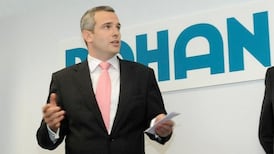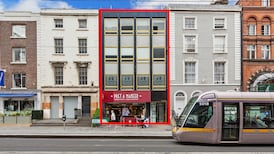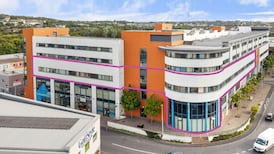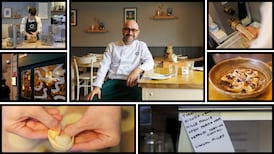HJ Nolan Ltd has been caught up in the seafood business for almost 90 years and is angling to keep its individuality in an era of supermarket ‘own brand’ dominance
THERE ARE many stories in Vincent Nolan’s life. They involve his love of music and travel, the people he’s met, the adventures he’s had. They all, in one way or another, come back to the company he built up after coming to Dublin from Belfast as an 18-year-old in 1941.
The company is HJ Nolan Ltd, otherwise and familiarly known to discerning palates since 1921 as “Nolan’s the seafood people”. Asked to account for his joie de vivre Vincent Nolan laughingly says he “bought and sold a lot of fish and ate a lot of it too”.
Today’s company prepares fish in a variety of ways in its state-of-the-art facility off Dublin’s Rathdown Road, at Nolan Seafoods (UK) Aberdeen and at the artisan-style Lossie Seafoods on the shores of Moray Firth in Scotland.
These days, too, it sells and distributes seafood products worldwide, 40 per cent of it its uniquely smoked salmon. The way Vincent Nolan tells it, it was all a hard-working adventure. The way his son, George, the third generation to take charge tells it, it still is.
“My father, H J (Harry) started the business selling fish in Belfast in 1921,” Vincent Nolan begins in an accent that, at 86 years old, is still the Belfast one he brought to Dublin 68 years ago. “He was born in Dublin, his father born in Leeds of Irish parents. My mother was Kathleen Rice from west Cork.”
So much for pedigree. Vincent went to school in St Malachy’s, Belfast, and during summer holidays was sent to Ardglass, Co Donegal, “to relatives who had a smoking house famous for kippers that are even mentioned in a Van Morrison song. I used help out and, aged 12 to 13, got the idea of starting a mail order business in smoked herring from Ardglass.”
It taught him a lot, he says. It was also the root of the Nolan smoked salmon business.
Harry Nolan branched out, set up another shop in the Dublin Fish Market, at East Arran Street, in 1931. Vincent, schooldays over, “came down to develop things in Dublin. It was 1941 and there was rationing, no cars on the roads – though there were still trucks, and horses and carts. You’d wake up on a winter morning to find no water, just ice. No central heating either.
“The ethos of the time was about not wasting anything. Fishermen sent their fish to the Dublin wholesale market and we’d buy there; even then I could see its days were numbered. The only fish we could import were smoked (from Scotland) or canned; we weren’t allowed import fresh fish.
“We got into processing fish and in 1960 bought this place (the Rathdown Road facility) and started developing the process of fish smoking. I learned a lot from travel, by seeing what was happening in places like Germany, in Scotland in particular. We started packing fresh fish and doing salt herrings.
“In 1960 I read a gourmet food column in the Sunday Times and, as a result, put an ad in that paper advertising our smoked salmon. It worked.”
And then there was the music, and his piano playing. George tells this part: “Vincent was known as ‘Fish Fingers’ because of his piano playing. He played with Hoagie Carmichael, met him in Palm Springs one morning and was with him until midnight. He met Sinatra, Dean Martin. He used send Sinatra smoked salmon on his birthday each year.”
Vincent, on cue, produces a gracious “thank you” card from Sinatra dated 1991. He became friendly, too, with governor Hugh Carey of New York (he of the “I love New York” slogan), another man who has, and continues to enjoy, a great deal of Nolan’s smoked salmon.
As the years went on the company had their own fishing boats. The Casamara, built by Tyrrell’s of Arklow, is remembered with affection, as is the Ann Rova, Unity, Easter Morn, Moravia. “Day Spring was the biggest fishing boat in Ireland in the 1970s,” Vincent says.
The company expanded – and so did the fledgling BIM (Bord Iascai Mhara), even to competing with companies like Nolan’s. When a meeting chaired by the then minister for agriculture and fisheries Charles Haughey was told by Vincent that the Fish Board was not helping matters, that taxpayers money was being wasted, action was taken.
“The next day,” Vincent says, “Haughey announced BIM was getting out of marketing and would do training instead. BIM started getting boats built and financing training. We got out of boats and started buying from the fishermen.”
Vincent Nolan married Yvonne Callaghan, from Dublin. She died in 2001. They had five sons and lived for a long time in Sutton, later in Foxrock. They called their first-born Harry; George and his twin Edward came next; then Vincent Jnr and lastly David. George was the one who choose, happily, to make the business his life.
“I love it, absolutely love it,” he says. Vincent says he knew George would go into the business because he was the one who used to fish for sea bass in Sutton and sell it to the hotels.
Father and son lament damage to fish stocks by overfishing and a technology that, George Nolan says, is “moving faster than nature can provide”.
He laments the “decimation” of stocks of deep-sea fish, like Orange Roughey and Black Scabbard, of closer-to-coast damage done to stocks of whiting and haddock. It’s not too late, he believes, to change fishery policies and build and build in safeguards.
George, after schooldays in Castleknock, came into the business in 1990-1991. “Before that I worked in Boston for a year-and-a-half, where I learned a lot, and in Belfast. I spent time in Ardglass, too. In 1991 we merged and got together as one with a number of companies we’d bought out. We’d closed Belfast in the 1970s. In 1995 we rebuilt and made this place a state-of-the-art facility for cooking, smoking and poaching quality salmon.
“We’ve done a lot more product development here, too. We bought-out the seafood division of a UK food group in Aberdeen in 2001 – now Nolan’s Seafood Aberdeen – and have built that up. Three years ago we bought an artisan smokery, Lossie Seafood in Buckie, north of Aberdeen.
“Lossie won ‘Exporter of the Year Award’, presented by Food From Britain in 2007, and sells to places like Caviar House in Paris, to Dubai, to high-end delis in New York, Hong Kong, Singapore. The seafood business has become global.”
HJ Nolan these days produces smoked and poached salmon in variety, mussels, crab meats, prawns and a range of frozen seafoods. Culture matters.
“We’re pushed by the big supermarkets to produce own brands for them but aren’t interested in doing that. We are now selling our own name product in Asda.
“As well as competing internationally and growing, we’re determined to keep our individuality. We must.”
Their enthusiasm for the business is palpable. Vincent says he’s moved back from involvement, George says he hasn’t. Vincent says the trick is to change all the time, “to adjust but not too quickly”. Both pay tribute to “the tremendous team” running the company. “Most of them are smarter than me,” says George, “and have a passion for it, you have to have. Bertie Broderick worked here for 55 years and died last year. We employ about 130 between here and Scotland.”
He pays tribute, too, to David Walters, operations director, to Jim Lawlor, financial controller, Alan Bellamy, production manager, forewoman Ann Ennis, foreman Noel Kelly and to Ray Conroy in dispatch. And then there’s Joan O’Brien, “a Kerrywoman, with us for 55 years, and the heart and soul of the company”.
George’s offspring, Andrew (26) and Laura (24) are pursuing careers in the arts and fashion respectively but George is hopeful one or other of them will have “something to contribute” to the company in time. A nephew is coming to work this summer. George has a lot to do still, and a long way to go with Nolan’s.
Vincent says he still eats kippers, still loves them, still keeps an eye on things.









